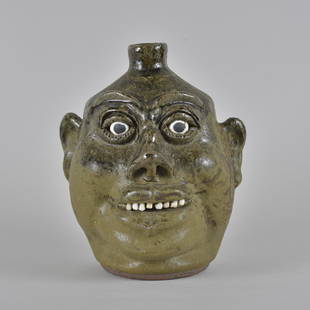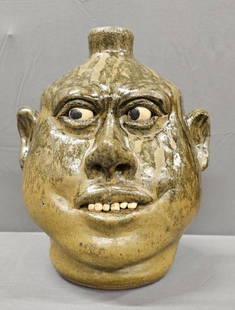
Lanier Meaders. Rare Early No-Ears Face Jug.
Lanier Meaders Sale History
View Price Results for Lanier MeadersRelated Jugs, Carafes & Pitchers
More Items from Lanier Meaders
View MoreRecommended Tableware & Barware
View More




















Item Details
Description
Lanier Meaders.
(1917-1998, Georgia)
Rare Early No-Ears Face Jug.
c.early 1960s.
Signed 'L M' in dark glaze on the base.
Olive green alkaline glaze with dark slip pupils.
Mint condition.
8"h.
Provenance: The Mike Dale Collection.
Est. $5,000-$8,000.
Ship: $65
Quillian Lanier Meaders was born on October 4, 1917, in Cleveland, Georgia, the second of four sons born to Cheever and Arie Meaders. His family had produced pottery in the Mossy Creek area since the last decade of the nineteenth century, beginning with his grandfather John Milton Meaders in the winter of 1892-1893. Meaders served with the airborne infantry in France during World War II.After the war, he came home to help with the family pottery, but also tried to find his own place outside the pottery world, working for a time in a sheet metal factory in Gainesville outfitting trailers, and working in a textile mill.
In 1967, a film crew from the Smithsonian Institution came to Mossy Creek to document on film the traditional pottery making processes still practiced by the Meaders family. Lanier's father Cheever was sick when the filmmakers arrived, so Lanier agreed to fill in for the production.The Smithsonian also placed an order for face jugs to be sold at its inaugural Smithsonian Festival of American Folklife to be held on the Mall in Washington, D.C. that summer 1967), and Lanier made the face jugs to fill the order.
The face jugs that Lanier made to be sold at the first Smithsonian Festival of American Folklife are identical to the Rare Early No-Ears Stoneware Face Jug offered here, the most notable features being the no-ears design and the 'L M' hand-brushed initials in dark glaze on the base. Typical of his early production period, the squat-shaped jug has a semi-rounded spout and is decorated with an applied clay face including ball-shaped glazed-over eyes inside recessed sockets, a large nose with depressed sides, and a closed mouth. These face jugs sold for $2.50 each and were a major hit at the Festival. They continued to be sold for many years at the Smithsonian Museum Gift Shop, although the styles of the face jugs, and their prices, evolved over time.
In November of that same year (1967), Cheever Meaders died, and at 50 years of age Lanier Meaders took over the Meaders Pottery and became a full-time potter for the first time.He continued the traditional ceramic craftsmanship of his forefathers, creating alkaline-glazed stoneware using a foot-powered treadle wheel and a wood-fired kiln. Lanier produced churns, milk pitchers, molasses and whiskey jugs, food storage jars, bean pots, candle holders, and other utilitarian vessels much like those made by his ancestors. Meaders realized that as utilitarian pottery became obsolete in the modern world, he needed to evolve as a potter if he wanted to survive. His transformation, from making utilitarian wares no one needed to making folk art objects many people wanted, was spectacular. He created fantastic vases and canister sets decorated with grapes or snakes, often in collaboration with his mother Arie. But his greatest contributions to folk art history are his face jugs.
The Rare Unsigned Rock Tooth Smiling Devil Face Jug, circa 1970, offered here is a form that has clearly evolved since the days of the Early No-Ears Stoneware Face Jug. This rare ovoid face jug has an applied clay devil's face including elliptical eyes, eyebrows, a well-sculpted nose, pierced ears, twisted horns, and a smiling mouth with two pointed rock teeth.Meaders' skill in crafting face jugs grew over time, and he continued to experiment with the form: rock teeth, clay teeth, china plate teeth, different glazes, runny eyes, double-faced politician's jugs, and devil jugs all took shape in his masterful hands. Each of the face jugs Meaders made has its own unique personality and charm reflecting the skill, and sense of humor, of its maker.
Meaders' contributions to Southern folk art and pottery have been widely recognized.In 1978, Lanier and his mother, Arie Meaders, were honorees of the Library of Congress with Meaders Pottery Day. He was a recipient of a 1983 National Heritage Fellowship from the National Endowment for the Arts, and he received the Governor's Award for the Arts in 1987. His work is part of the permanent collections of many museums and institutions, including the Smithsonian American Art Museum, Renwick Gallery, Washington, D.C.; the American Folk Art Museum, New York, N.Y.; the Southern Highland Craft Guild, Asheville, NC; the McKissick Museum, University of South Carolina, Columbia, SC; the Georgia Museum of Art, Athens, GA; and the Folk Pottery Museum of Northeast Georgia, Sautee Nacoochee, GA, to name a few. Meaders married late in life, to Bettie Jean Lewis, on September 10, 1988. He died on February 5, 1998.
(1917-1998, Georgia)
Rare Early No-Ears Face Jug.
c.early 1960s.
Signed 'L M' in dark glaze on the base.
Olive green alkaline glaze with dark slip pupils.
Mint condition.
8"h.
Provenance: The Mike Dale Collection.
Est. $5,000-$8,000.
Ship: $65
Quillian Lanier Meaders was born on October 4, 1917, in Cleveland, Georgia, the second of four sons born to Cheever and Arie Meaders. His family had produced pottery in the Mossy Creek area since the last decade of the nineteenth century, beginning with his grandfather John Milton Meaders in the winter of 1892-1893. Meaders served with the airborne infantry in France during World War II.After the war, he came home to help with the family pottery, but also tried to find his own place outside the pottery world, working for a time in a sheet metal factory in Gainesville outfitting trailers, and working in a textile mill.
In 1967, a film crew from the Smithsonian Institution came to Mossy Creek to document on film the traditional pottery making processes still practiced by the Meaders family. Lanier's father Cheever was sick when the filmmakers arrived, so Lanier agreed to fill in for the production.The Smithsonian also placed an order for face jugs to be sold at its inaugural Smithsonian Festival of American Folklife to be held on the Mall in Washington, D.C. that summer 1967), and Lanier made the face jugs to fill the order.
The face jugs that Lanier made to be sold at the first Smithsonian Festival of American Folklife are identical to the Rare Early No-Ears Stoneware Face Jug offered here, the most notable features being the no-ears design and the 'L M' hand-brushed initials in dark glaze on the base. Typical of his early production period, the squat-shaped jug has a semi-rounded spout and is decorated with an applied clay face including ball-shaped glazed-over eyes inside recessed sockets, a large nose with depressed sides, and a closed mouth. These face jugs sold for $2.50 each and were a major hit at the Festival. They continued to be sold for many years at the Smithsonian Museum Gift Shop, although the styles of the face jugs, and their prices, evolved over time.
In November of that same year (1967), Cheever Meaders died, and at 50 years of age Lanier Meaders took over the Meaders Pottery and became a full-time potter for the first time.He continued the traditional ceramic craftsmanship of his forefathers, creating alkaline-glazed stoneware using a foot-powered treadle wheel and a wood-fired kiln. Lanier produced churns, milk pitchers, molasses and whiskey jugs, food storage jars, bean pots, candle holders, and other utilitarian vessels much like those made by his ancestors. Meaders realized that as utilitarian pottery became obsolete in the modern world, he needed to evolve as a potter if he wanted to survive. His transformation, from making utilitarian wares no one needed to making folk art objects many people wanted, was spectacular. He created fantastic vases and canister sets decorated with grapes or snakes, often in collaboration with his mother Arie. But his greatest contributions to folk art history are his face jugs.
The Rare Unsigned Rock Tooth Smiling Devil Face Jug, circa 1970, offered here is a form that has clearly evolved since the days of the Early No-Ears Stoneware Face Jug. This rare ovoid face jug has an applied clay devil's face including elliptical eyes, eyebrows, a well-sculpted nose, pierced ears, twisted horns, and a smiling mouth with two pointed rock teeth.Meaders' skill in crafting face jugs grew over time, and he continued to experiment with the form: rock teeth, clay teeth, china plate teeth, different glazes, runny eyes, double-faced politician's jugs, and devil jugs all took shape in his masterful hands. Each of the face jugs Meaders made has its own unique personality and charm reflecting the skill, and sense of humor, of its maker.
Meaders' contributions to Southern folk art and pottery have been widely recognized.In 1978, Lanier and his mother, Arie Meaders, were honorees of the Library of Congress with Meaders Pottery Day. He was a recipient of a 1983 National Heritage Fellowship from the National Endowment for the Arts, and he received the Governor's Award for the Arts in 1987. His work is part of the permanent collections of many museums and institutions, including the Smithsonian American Art Museum, Renwick Gallery, Washington, D.C.; the American Folk Art Museum, New York, N.Y.; the Southern Highland Craft Guild, Asheville, NC; the McKissick Museum, University of South Carolina, Columbia, SC; the Georgia Museum of Art, Athens, GA; and the Folk Pottery Museum of Northeast Georgia, Sautee Nacoochee, GA, to name a few. Meaders married late in life, to Bettie Jean Lewis, on September 10, 1988. He died on February 5, 1998.
Buyer's Premium
- 25%
Lanier Meaders. Rare Early No-Ears Face Jug.
Estimate $5,000 - $8,000
45 bidders are watching this item.
Shipping & Pickup Options
Item located in Buford, GA, us$65 shipping in the US
Local Pickup Available
Payment
Accepts seamless payments through LiveAuctioneers

TOP





































![[POTTERY]. Pair of Rare Toby Jugs, Including a Large Staffo...: [POTTERY]. Pair of Rare Toby Jugs, Including a Large Staffordshire Jug. [England, ca. early to mid-19th century]. Staffordshire jug of a handsomely - painted seated squire with a pitcher, and a small](https://p1.liveauctioneers.com/928/328184/176813308_1_x.jpg?height=310&quality=70&version=1714496988)

![[POTTERY]. Pair of Rare Illustrated Jugs Plus a Rare Illust...: [POTTERY]. Pair of Rare Illustrated Jugs Plus a Rare Illustrated Mug. [V.p., ca. 19th century]. Pitchers approximately 5 ½” high, mug approximately 5 ½”. Items worn, soiled, all](https://p1.liveauctioneers.com/928/328184/176813309_1_x.jpg?height=310&quality=70&version=1714496988)



























